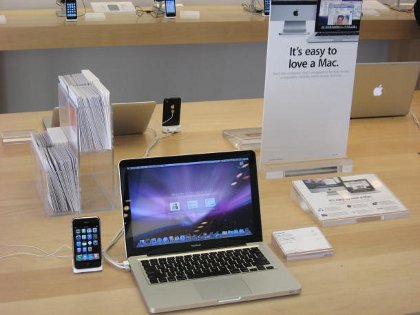Is Apple getting ready for an 'iPad'

A recent article in the Wall Street Journal said that, during his medical leave, Apple chief executive Steve Jobs has been working on a kind of mid-sized mobile device. BusinessWeek also recently reported that Apple is developing a 'media pad' that would let users watch videos on a screen larger than an iPod touch or Amazon's Kindle e-book reader, but on a device that's more portable than notebooks and lacks a keyboard.
The personal computer industry has long tried to make such a device a reality, but apart from some early success for the Kindle, no one has managed to convince the public that the attempts released to date — such as the ultramobile PC — are worth buying. Instead, PC companies looking for increased mobility are finding ways to shrink the notebook PC instead of finding a new way to use computers.
As far back as 2000, Microsoft founder Bill Gates was evangelizing tablet PCs, but a combination of price and uninspired software doomed that category to niche status. Intel and Microsoft then turned the hype machine to the UMPC (later rebranded as mobile Internet device or MID), which aren't exactly flying off store shelves.
More recently, PC companies have embraced netbooks — small inexpensive mini-notebook computers that are designed for basic Web surfing and email. Netbooks, however, are further depressing the PC industry's gross margins and attempt to cram a full-fledged notebook user interface into a small package, and it doesn't seem that Apple is all that crazy about this category.
But Apple has developed a few unique ideas for mobile computing over the past two years that have resonated with designers, developers and users: namely, the iPhone OS and the App Store. Is the timing finally right for the 'tweener' computer?
BusinessWeek reported that the 'iPad' (name taken from Silicon Alley Insider) would be about the size of the Kindle, but with a screen that covers a greater portion of the surface. The Kindle's the screen is just 6 inches and doesn't cover its entire body; by comparison, the iPhone sports an 3.5-inch display, while the smallest MacBook uses a 13.3-inch display.
Previous attempts at making keyboard-less devices with larger screens haven't captured the public's imagination. Microsoft and Intel had high hopes for the concept in 2006, which was also known as Project Origami inside Microsoft. Samsung made perhaps the best-received MID, but interest in the category quickly faded after the launch of the iPhone.
The main issue with MIDs was a lack of compelling software. They were designed to run Windows XP, which itself wasn't designed to run on a device with such a small screen and limited methods of input. At launch, Windows Vista was actually a step backward in terms of its suitability for mobile devices.
Intel tried to shift MIDs to Linux to get around the resource problems of Windows Vista, but its partners have yet to gain any traction. Neither attempt was able to galvanize third-party developers into creating applications designed specifically for a mobile platform.
Apple's iPhone OS, however, was designed for a small-screen mobile environment. Installing the iPhone OS 3.0 on the iPad would allow Apple to preserve the user interface from the iPhone and iPod touch and keep the device simple. A more complicated — and power hungry — operating system isn't needed for a computer like this.
Apple could also take advantage of the App Store, giving the iPad thousands of applications at its disposal right from launch. One potential problem with that approach is that developers will have to rewrite their iPhone applications to adapt to the larger-size screen on this new device, said Craig Hockenberry of Iconfactory, creators of Twitterific.
Hockenberry, who is very confident that Apple has such a device in the works, doesn't think this will be a huge obstacle, but developers will have to gauge whether the extra development effort is worth their time. One thing Apple could do is set aside a separate section of the App Store for iPad-optimized applications, while finding a way to run older iPhone applications in some sort of compatibility mode.
"It wouldn't be hard for Apple to have a 'Classic' environment on a tablet that provided a 320x480-pixel window for running one or more iPhone applications," Hockenberry said in an email. "It would be a smart thing for them to do: there are instantly tens of thousands of apps and users are presented with a familiar interface (something that looks a lot like Dashboard in Mac OS X)."
The iPad could also be the first Apple product to surface with a chip designed by PA Semi. A custom chip could solve two problems for Apple — the need to keep software compatibility with the ARM-based chips used to run the iPhone while delivering more performance for HD video playback or more robust games that competitors might not be able to immediately match.
There are two schools of thought on the pricing of such a device. UMPCs, at around $700 (£475), were considered too expensive but because they didn't offer any value, not because of the sticker price itself. It would not be hard for Apple to argue that an iPad with an HD screen, thousands of applications and a superior mobile browser is worth just slightly more than what people were willing to pay for the original iPhone.
A $699 iPad would slot nicely between the iPod touch and MacBook in Apple's product lineup and preserve Apple's profit margins. It might also allow the company to reduce the price over time if needed, similar to the original iPhone.
But Apple could also hook up with a wireless carrier to subsidize the iPad. The company has reportedly been in talks about distributing MacBooks through wireless carrier friends like AT&T in the US, which already sells 3G-equipped netbooks with a data plan subscription.
This is the last frontier of the promised convergence between computers and communication devices. That shift has already happened to the smartphone, but it seems very reasonable that, for many people, smartphone screens are too small for serious computing.
If Apple is indeed working on such a product, it will have to get the implementation right to avoid duplicating the failures of so many other mobile computing aspirants. But by having awakened the public to the promise of basic mobile computing, Apple could be best positioned to capitalize on the need for something more.

This article was originally posted on CNET News.